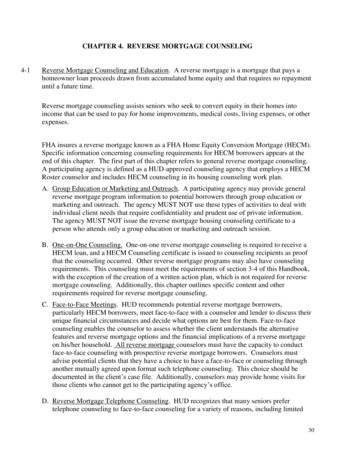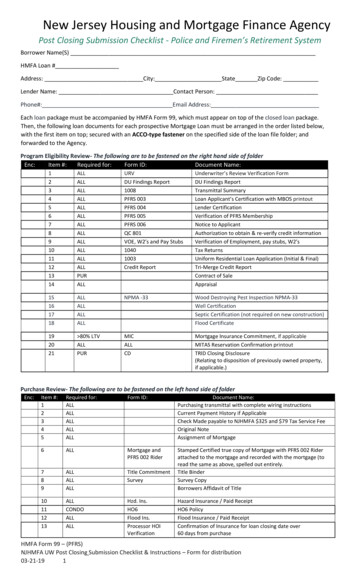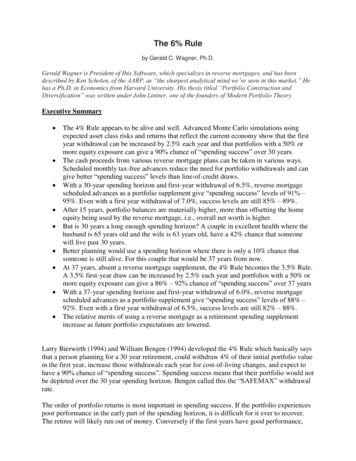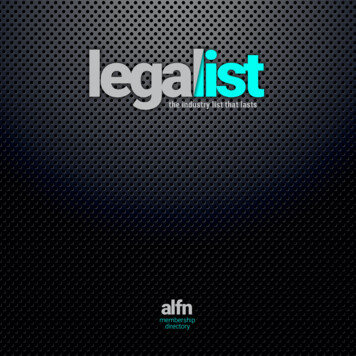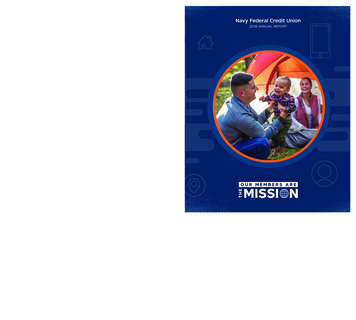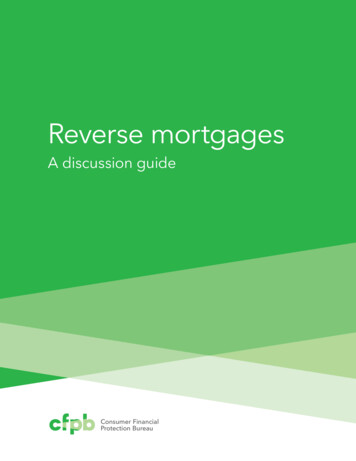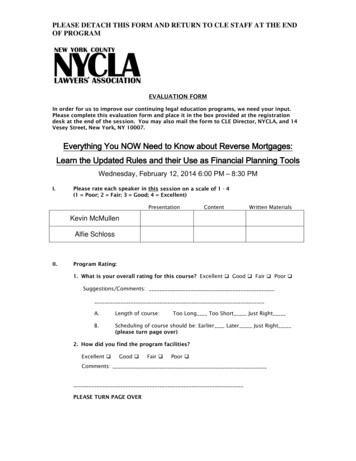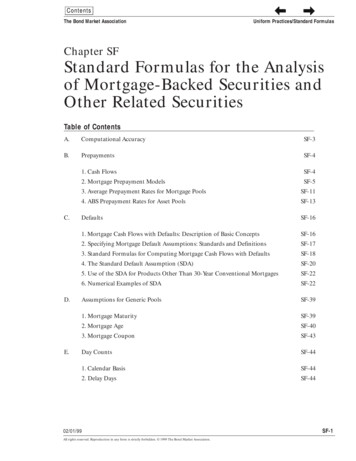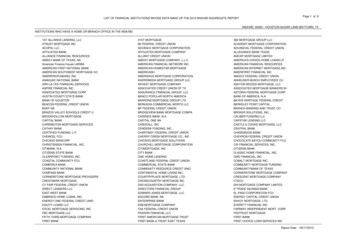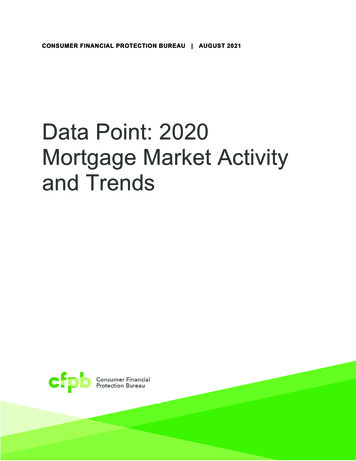
Transcription
CONSUMER FINANCIAL PROTECTION BUREAU AUGUST 2021Data Point: 2020Mortgage Market Activityand Trends1
This is another in an occasional series of publications from the Consumer Financial ProtectionBureau’s Office of Research. These publications are intended to further the Bureau’s objective ofproviding an evidence-based perspective on consumer financial markets, consumer behavior,and regulations to inform the public discourse. See 12 U.S.C. §5493(d). [1][1]This report was prepared by Feng Liu, Young Jo, Vanessa Jimenez-Read, and Alex Rodrigue.2DATA POINT: 2020 MORTGAGE MARKET ACTIVITY AND TREND
Table of contentsTable of contents. 31. Introduction . 42. Mortgage applications and originations . 103. Mortgage outcomes by demographic groups and loan types . 163.1 Distribution of home loans . 163.2 Mortgage characteristics of home loans . 203.3 Denial rates . 274. Monthly mortgage trends and activities. 315. Mortgage trends and activities by states . 466. Lending institutions . 497. Conclusion . 553
1. IntroductionThis Data Point article provides an overview of residential mortgage lending in 2020 based onthe data collected under the Home Mortgage Disclosure Act (HMDA). HMDA is a datacollection, reporting, and disclosure statute enacted in 1975. HMDA data are used to assist indetermining whether financial institutions are serving the housing credit needs of their localcommunities; facilitate public entities’ distribution of funds to local communities to attractprivate investment; and help identify possible discriminatory lending patterns and enforceantidiscrimination statutes. 1 Institutions covered by HMDA are required to collect and reportspecified information about each mortgage application acted upon and mortgage purchased.The data include the disposition of each application for mortgage credit; the type, purpose, andcharacteristics of each home mortgage application or purchased loan; the census-tractdesignations of the properties; loan pricing information; demographic and other informationabout loan applicants, such as their race, ethnicity, sex, age, and income; and information aboutloan sales. 2The 2020 HMDA data3 are the third year of data that incorporate amendments made to HMDAby the Dodd-Frank Wall Street Reform and Consumer Protection Act of 2010 (DFA). Among thechanges made by the DFA were new data points, revisions to certain existing data points, andauthorizing the Bureau to require the collection and reporting of additional data points. TheBureau issued a final rule implementing these and other changes in October 2015 (2015 HMDArule). 4 The 2015 HMDA rule made five primary changes to the data collected starting onJanuary 1, 2018: (1) mandated reporting of open-end lines of credit (LOCs) by financialinstitutions with an annual LOC origination volume exceeding a coverage threshold of 100 LOCsFor a brief history of HMDA, see Federal Financial Institutions Examination Council, “History ofHMDA,” available at www.ffiec.gov/hmda/history2.htm (last modified Sept. 06, 2018) .2 See Filing instructions guide for HMDA data collected in 2020 (June 2020), available elp/2020-hmda-fig.pdf for a full list of itemsreported under HMDA for 2020.3 The 2020 HMDA data, which are used for the analysis of this Data Point, cover mortgage applicationsacted upon and mortgages purchased during the calendar year of 2020 and reported in 2021. Similarly,the 2018 and 2019 HMDA data refer to applications acted upon and mortgages purchased during thecalendar years of 2018 and 2019 respectively.4 See Home Mortgage Disclosure (Regulation C), 80 FR 66128 (Oct. 28, 2015). In September 2017, theBureau published in the Federal Register a rule which made a few technical corrections to and clarifiedcertain requirements of the rule implementing HMDA. This rule also increased the threshold forcollecting and reporting data about LOCs for a period of two years. See Home Mortgage Disclosure(Regulation C), 82 FR 43088 (Sep. 13, 2017).14
in each of the two preceding years 5; (2) changed the transactional coverage definition from loanpurpose-based to one based primarily on whether the loan was secured by a dwelling; (3)modified definitions and values of some existing data points; (4) required reporting of 27 newdata points 6; and (5) established a uniform coverage threshold of 25 closed-end loanoriginations in each of the two preceding years for depository institutions (DIs) and nondepository institutions (non-DIs) to report closed-end loans, with the closed-end thresholdchange for DIs taking effect on January 1, 2017. 7Because of these significant changes starting with the 2018 HMDA data, the HMDA data since2018 are not completely comparable to the HMDA data before 2018. To maintain theconsistency for cross-year comparisons, this article uses only the HMDA data from 2018 to 2020and focuses on trends in mortgage applications and originations during these three years. Indoing so, we have incorporated a number of new and revised data points that were not collectedprior to the 2018 HMDA data. We have also incorporated analyses of LOCs and other dwellingsecured transactions in the article. We note that readers who are interested in the historicaltrends of mortgage applications and activities prior to 2018 can refer to the previous CFPBpublications. 8 Lastly, some estimates in this article are not completely consistent with thosefrom the previous CFPB publications because some records were dropped in the previouspublications to make the post-2018 data consistent with the pre-2018 data. 9On June 17th, 2021, the Bureau published a static application-level 2020 HMDA data file thatconsolidates data from individual reporters. The data file is modified to protect applicant and5 The 2017 HMDA rule temporarily increased the 100-LOC coverage threshold to 500 LOCs for the 2018and 2019 HMDA data. Then, the 2019 HMDA rule extended the 500-LOC threshold to the 2020 and 2021HMDA data. See Home Mortgage Disclosure (Regulation C), 84 FR 57946 (Oct. 29, 2019); 82 FR 43088(Sept. 13, 2017).6 Beginning with the 2018 HMDA data, the Economic Growth, Regulatory Relief, and ConsumerProtection Act (EGRRCPA) exempted certain insured depository institutions and credit unions from therequirement to collect and report data on 26 of the 27 new data points added under the 2015 HMDA rulefor certain types of transactions. For more details on the new data points, see the article “An UpdatedReview of the New and Revised Data Points in HMDA: Further Observations using the 2019 HMDA data,”available at arch-reports/revised-data-pointshmda/7 This 25-loan coverage threshold was increased to 100 loans in May of 2020 by the 2020 HMDA rule,which became effective on July 1, 2020. See Home Mortgage Disclosure (Regulation C), 85 F. R. 28364(May 12, 2020), available at .8 See “Data Point: 2018 Mortgage Market Activity and Trends,” available vity-and-trends/.9 In previous CFPB publications examing trends and activity in mortgage markets since the 2018 HMDAdata were reported, the Bureau excluded all open-end LOCs, except those that are reverse mortgages, andapplications for a loan purpose other than home purchase, home improvement, or refinance.5
borrower privacy. 10 The data file and the Data Point article reflect the data as of April 31, 2021.Though this static file will not change, the Bureau will also provide an updated file separately toreflect any later resubmissions or late submissions. The results using the updated file may differfrom those reported in this Data Point article, although the Bureau expects them to be largelyconsistent.The remainder of this article summarizes the 2020 HMDA data and recent trends in mortgageapplications and originations. Some of the key findings are: 11 4,472 financial institutions reported at least one closed-end record in 2020, down by18.8 percent from 5,505 financial institutions who reported in 2019. In total, the number of closed-end originations (excluding reverse mortgages) in 2020increased by 65.2 percent, from 8.3 million in 2019 to 13.6 million in 2020. Most of theincrease was driven by an increase in the number of refinance loans. For example, thenumber of home-purchase loans secured by site-built one-to-four-family propertiesincreased by about 387,000, whereas the number of refinance loans increased by 149.1percent from 3.4 million in 2019 to 8.4 million in 2020. The number of open-end lines of credit originations excluding reverse mortgages(HELOCs 12) in 2020 decreased by 16.6 percent, from 1.04 million in 2019 to 869,000 in2020. The share of loans secured by closed-end home-purchase loans for site-built, one-tofour-family, first lien, principal-residence properties for Black borrowers increased in2020 and the share of refinance loans for Asian borrowers increased in 2020.For more information concerning these modifications and the Bureau’s analyses under the balancingtest it adopted to protect applicant and borrower privacy while also fulfilling HMDA’s disclosurepurposes, see Disclosure of Loan-Level HMDA Data 84 FR 649 (Jan. 31, 2019).11 This Data Point article is based on the analysis of the static consolidated application-level 2018, 2019,and 2020 HMDA data files. Some data points used in this article were modified or withheld in the publicHMDA data.12 Open-end lines of credit secured by dwellings (excluding reverse mortgages) are commonly known ashome equity lines of credit, or HELOCs. In the rest of the article, where it is applicable, we have used theterm HELOC in lieu of open-ended line of credits excluding reverse mortgage. Beginning with the datacollected in 2018, the reporting of HELOCs became mandatory rather than optional.106
Black and Hispanic white borrowers had lower median loan amounts, lower mediancredit scores, higher denial rates, and paid higher median interest rates and total loancosts compared to non-Hispanic white and Asian borrowers. 13 In April and May of 2020, contrary to typical seasonal patterns, the home-purchaseorigination volume declined, likely reflecting the effects of the pandemic and nationwideshutdown. Starting in June of 2020, the home-purchase volume recovered and increasedsignificantly in terms of year-over-year comparison despite the typical low home saleseasons near the end of the year. The refinance boom observed in 2020 largely was the continuation of the trends sincethe second quarter of 2019.One factor that may affect comparing the mortgage market trends in 2020 to those in 2018 and2019 is the change in one of the two reporting thresholds in Regulation C. Specifically, thereporting threshold for closed-end transactions in 2020 was higher than the threshold in 2018and 2019. The 2015 HMDA rule 14 required, among other things, that financial institutionsreport their closed-end mortgage activities under HMDA if they (1) originated no fewer than 25closed-end mortgage loans in each of the two preceding years and (2) meet other reportingcriteria such as asset and locational tests. This “25-loan” closed-end reporting threshold appliedto the HMDA reporting activities in 2018 and 2019. However, CFPB raised this 25-loanthreshold to a 100-loan threshold in May of 2020 (2020 HMDA rule), which became effectiveon July 1, 2020. 15 16A recent CFPB publication shows that there is heterogeneity in mortgage characteristics across AsianAmerican Pacific Islander subgroups. The report titled “Asian American and Pacific Islanders in theMortgage Market,” is available at n-the-mortgage-market/14 See Home Mortgage Disclosure (Regulation C), 80 F. R. 66127 (Oct. 28, 2015), available -c.15 See Home Mortgage Disclosure (Regulation C), 85 F. R. 28364 (May 12, 2020), available -c.16 Even though the 2020 HMDA rule changed the open-end reporting threshold to 200-LOCs, the changedoes not take into effect until January 1st, 2022. For the HMDA activity years of 2018 to 2020, the openend reporting threshold had remained constant at 500-LOCs. The 2017 HMDA rule initially set thethreshold to 500-LOCs temporarily for the 2018 and 2019 HMDA data. Then, the 2019 HMDA ruleextended the 500-LOC threshold to the 2020 as well as 2021 HMDA data. Therefore, the open-endreporting threshold change by the 2020 HMDA rule had no effect on the analysis of open-end LOCs inthis report.137
In the 2020 HMDA data, 4,472 financial institutions reported at least one record that is notflagged as an open-end line of credit. 17 Among the closed-end reporters, 200 reported fewerthan 25 closed-end originations, 588 reported between 25 and 99 closed-end originations, and3,678 reported at least 100 closed-end originations.The HMDA reporting volume thresholds are set with a two-year lookback period. In total, basedon the 2018 and 2019 HMDA data, 4,919 financial institutions reported at least 25 closed-endmortgage originations in both 2018 and 2019, 3,235 financial institutions reported at least 100closed-end mortgage originations in both 2018 and 2019, and 1,684 financial institutionsreported at least 25 closed-end mortgage originations in both 2018 and 2019 but had fewer than100 closed-end originations in at least one of these two years. These 1,684 financial institutionswould have been required to report their closed-end activities in 2020 according to the 2015HMDA rule, but were no longer required to report under the 2020 HMDA rule. Together, these1,684 newly exempted financial institutions reported about 120,000 closed-end loans in 2018,accounting for 1.9% of all closed-end originations reported in 2018, and about 116,000 closedend loans in 2019, accounting for 1.4% of all closed-end originations reported in 2019.Among the newly exempted financial institutions, more than half voluntarily reported closedend activities in the 2020 HMDA data, even though they were no longer required to do so. Ofthe 1,684 newly exempted financial institutions, 893 reported about 116,000 closed-endoriginations, while 791 did not report any closed-end activities in the 2020 HMDA data. TheseThe HMDA data since 2018 contain a data point indicating whether the covered loan is, or theapplication is for, an open-end line of credit. This data point, however, is among the partially exempt datapoints under the EGRRCPA. The allowable values for this field include “Code 1—Open-end line of credit,Code 2—Not an open-end line of credit, Code 1111—Exempt”. Under the EGRRCPA, depositoryinstitutions that originated less than 500 closed-end originations in each of the preceding two yearsgenerally do not have to report partially exempt data points for their closed-end transactions, anddepository institutions that originated less than 500 open-end originations in each of the preceding twoyears generally do not have to report partially exempt data points for their open-end transactions. On theother hand, for HMDA activity years between 2018 and 2020, a financial institution that originated nofewer than 500 open-end lines of credit in both of the preceding two years and meet other criterion mustreport their open-end activities to HMDA. Given so, in these three years, financial institutions that wereeligible for the partial exemption for open-end transactions under the EGRRCPA have not been requiredto report any open-end lines of credit to HMDA . Therefore, in the rest of the report, we have assumed allrecords with the open-end lines of credit flag reported as “Exempt” to be closed-end transactions. Weacknowledge that it is possible that some reporters had voluntarily reported open-end transactions andreported an open-end flag as “Exempt”. To the extent that such voluntary reporting of open-end lines ofcredit exists, the numbers of closed-end records would be overestimated in this report. In the 2020HMDA data, about 1.73 million records were reported as open-end lines of credit, 23.2 million recordswere affirmatively reported as not open-end lines of credit, and 578,000 records had the open-end lineof-credit flag reported as “Exempt”. For originated loans, about 906,000 records were reported as openend lines of credit, 13.2 million records were affirmatively reported as not open-end lines of credit, and432,000 records had the open-end lines of credit flag reported as “Exempt”.178
791 financial institutions reported about 73,000 closed-end originations in 2019, accounting forless than one percent of all closed-end originations.The closed-end origination volume reported to HMDA increased from about 8.26 million in2019 to about 13.64 million in 2020, or about a 65.2% increase. This increase occurred despitethe increase in the closed-end reporting threshold. Given the substantial increase in totalorigination volume reported and small origination volume of the newly exempted financialinstitutions that did not report 2020 HMDA data, the impact of the threshold change likely didnot significantly affect the overall trends and patterns presented in this article.9
2. Mortgage applications andoriginationsIn 2020, a total of 4,475 financial institutions—banks, savings associations, credit unions, andnon-depository mortgage lenders—reported data on approximately 22.7 million applicationsand 14.5 million originations under HMDA. In contrast, in 2019, 5,508 financial institutionsreported data on 15.1 million applications and 9.3 million originations under HMDA. Comparedto 2019, the number of reporters decreased by 1,033, or about 18.8 percent, likely due primarilyto the increase in the closed-end reporting threshold that was implemented by the 2020 HMDArule. On the other hand, despite the drop in the number of financial institutions reportingHMDA data, the total number of applications and originations increased substantially in 2020.The total number of reported applications increased by about 7.5 million or 50 percent and thenumber of originations increased by 5.2 million or 56.0 percent.The bottom rows of Table 1 present the total count of the number of records, including totalapplications, originations, purchased loans, and requests for approvals reported each year from2018 to 2020. The top panels of Table 1 break down the total records by types of transactions:closed-end excluding reverse mortgages, open-end line of credits excluding reverse mortgage, orreverse mortgages. Within closed-end transactions, we further divide by property types: a sitebuilt one-to-four family unit, manufactured home, or multifamily transactions. We alsocategorize by loan purposes: home purchase, home improvement, refinance, and other purpose.The closed-end site-built one-to-four family originations are then disaggregated by lien status(e.g., first lien, junior lien) and occupancy types (e.g., principal residence, second residence,investment property). Then, the first-lien, principal-residence originations are furtherdisaggregated by whether they are conventional loans or not. Within the conventional loancategory, we disaggregate by whether the loan is conforming or jumbo. Within the nonconventional loan category, we disaggregate by loans insured or guaranteed by Federal HousingAdministration (FHA), Department of Veterans Affairs (VA), or USDA Rural Housing Service orFarm Service Agency (RHS/FSA). For manufactured home originations, we disaggregate bywhether manufactured home loans are secured by land (non-chattel loans) or not secured byland (chattel loans). 18Manufactured-home lending differs from lending for site-built homes. Furthermore, even among themanufactured home loans, chattel-secured lending differs greatly from those that are not chattel secured.1810
The large increase in the total number of originations and applications in 2020 is driven by theincrease in closed-end mortgages. The number of HELOC records continued its downward trendfrom 2018 and the total number of HELOC originations declined from 1.042 million in 2019 to869,000 in 2020. On the other hand, the total number of reverse mortgage originationsincreased from 35,000 to 43,000 year over year.The total number of closed-end site-built single-family originations reported in 2020 HMDAincreased by approximately 5.4 million (66.8 percent). 19 Lenders reported approximately 13.4million closed-end site-built single-family originations in 2020, up from just over 8.0 millionoriginations in 2019. In addition, lenders reported around 20.3 million closed-end site-builtsingle-family applications, which includes 4.3 million applications that the lenders closed asincomplete or the applicant withdrew before the lender made a decision.About 90 percent of the increase in closed-end site-built single-family originations in 2020 wasdriven by the increase in refinance loans. Refinance originations increased from 3.4 million in2019 to 8.4 million in 2020, which is an approximately 5.0 million or 149 percent increase.Refinance applications for site-built single-family properties also increased from 5.8 million in2019 to 13.2 million in 2020. More detailed information on refinance loans available in the 2020data (not in the tables) shows that less than half (41.1 percent) of refinance loans were cash-outrefinances. This contrasts with 2018 when cash-out refinance loans accounted for 56.3 percentof all refinance loans.The large expansion of refinance activities in 2020 is especially prominent in the conventionalconforming space, with the refinance volume of conventional conforming loans 20 increasingfrom around 2.1 million in 2019 to just over 6.2 million in 2020, representing a net increase ofmore than 190 percent. Refinance volume of VA loans also experienced a significant increase in2020, rising by close to 126.2 percent from 415,000 in 2019 to 938,000 in 2020. In contrast, theincrease in refinance volumes in jumbo loans and FHA loans were relatively more moderate,increasing by only 27.9 percent and 41.4 percent, respectively, in 2020.Chattel-secured lending typically carries higher interest rates and shorter terms to maturity. The rest ofthis article focuses almost entirely on site-built mortgage originations, which constitute most originations.For more information on manufactured housing, see “Manufcatured Housing Finance: New insights fromthe Home Mortgage Disclousre Act,” available at hts-hmda/.19 Throughout the rest of the report, calculations in the text are based on precise data values. Usingrounded numbers from the tables may lead to different values due to rounding errors.20 Conventional conforming mortgage secured by closed-end site-built single-family first-lien principalresidence.11
The closed-end site-built single-family mortgage originations for home purchase rose by amodest 9.0 percent, from just over 4.3 million in 2019 to nearly 4.7 million in 2020. Whenlimited to the first-lien principal residence, the home-purchase loan originations increased by9.8 percent, from 3.7 million in 2019 to 4.1 million in 2020. Among them, the conventionalconforming market saw the largest increase of 12.1 percent in 2020, while the jumbo loans saw adecrease of 7.6 percent.In 2020, about 197,000 loans secured by manufactured homes were originated, compared to173,000 such loans in 2019. About 137,000 manufactured home loans were taken out for homepurchase, up slightly from 128,000 in 2019. Among them, about 71,000 were secured by bothhome and land, while 57,000 were secured by a manufactured home but not land.The decrease in interest rates was likely a main driver behind the substantial increase inrefinance applications and loans. Average interest rates declined throughout 2020 and werelower in 2020 than in 2019. According to Primary Mortgage Market Survey 21, the average rateon 30-year fixed-rate conventional conforming mortgage loans started at 3.72 percent at thebeginning of 2020 and decreased to a historically lowest level of 2.67 percent by the end of2020. In contrast, interest rates decreased from 4.51 percent at the beginning of 2019 to 3.74percent by the end of 2019. The reported interest rates in HMDA data follow a consistentpattern. The median interest rate for 30-year fixed-rate conventional conforming loans securedby first-lien principal residence for borrowers with a credit score of at least 620 was 3.125 in the2020 HMDA data compared to 4.125 in the 2019 HMDA data.Finally, HMDA data include information on loans purchased by reporting institutions duringthe reporting year, although the purchased loans may have been originated before 2020. Table 1shows that financial institutions purchased 2.8 million loans from other institutions in 2020, a21.6 percent increase from 2019.This measure comes from Freddie Mac’s Primary Mortgage Market Survey and is available from theFederal Reserve Bank of St. Louis’ Federal Reserve Economic Database (FRED) 2112
TABLE 1: APPLICATIONS, ORIGINATIONS, PRE-APPROVALS, AND LOAN PURCHASES (IN THOUSANDS)Home PurchaseRefinanceHome ImprovementOther PurposeTotal 6034341521,43348593810963 1752 1422 143 1 154 1 132 1 irst lien, second residence1731782273156159222556212241394First lien, investment or lien, all occupancy typesMANUFACTURED 738362504165536173622197Manufactured home loans secured byland64677126304522122194101118Manufactured home loans not securedby land495257224 1 1 1 1 1 1515461Land secured status unknown12109677 1 1 1 1 1 1201818A. Closed-end excluding reversemortgageSITE BUILT 1-4 FAMILYApplicationsOriginationsFirst lien, principal residenceConventional(2)Conventional conformingConventional jumboNonconventionalFHAVARHS/FSA13
Home PurchaseRefinanceHome ImprovementOther PurposeTotal 0201820192020282229232419312533273731222211 1 1 1 1 1 1615065536452B. Open-end excluding reverse ,2581,1242,1001,0421,6558693232324928482958391 1111 1433222573355356443Total applicationsTotal 1Purchased 62,756Requests for preapproval(4)467445366 1 1 1 1 1 1 1 1 1467445366Requests for preapproval that wereapproved but not acted on757471 1 1 1 1 1 1 1 1 1757471Requests for preapproval that weredenied1027758 1 1 1 1 1 1 1 1 11027758MULTIFAMILY(3)ApplicationsOriginationsC. Reverse mortgageApplicationsOriginationsNOTE: Components may not sum to totals because of rounding. Applications include those withdrawn and those closed for incompleteness. FHA is FederalHousing Administration; VA is U.S. Department of Veterans Affairs; FSA is Farm Service Agency; RHS is Rural Housing Service.(1) The sum of Home Purchase, Refinance, Home Improvement, and Other Purpose columns may not sum to Total columns because a small number of recordsreported loan purpose as “NA”. For instance, in 2020 HMDA data, a little over 600 originations had loan purpose reported as “NA”, likely due to reporting errors.In addition, for purchased loans where the origination occurred before January 1, 2018, reporters are allowed to report the loan purpose data point as “NA”.About 234,000, 177,000 and 358,000 purchased loans had loan purpose reported as “NA” in 2018, 2019, and 2020 HMDA data respectively.(2) The sum of conventional conforming and conventional jumbo rows may not sum to the conventional row because a small number of records had anunknown conforming loan status. The conventional conforming loan is a closed-end forward mortgage (i.e. excluding reverse mortgage) transaction whose loantype is reported as conventional and whose loan amount is below the conforming loan limit, making it eligible to be purchased by Fannie Mae or Freddie Mac14
(collectively known as Government Sponsored Enterprises, or GSEs). The conventional non-con
3 The 2020 HMDA data, which are used for the analysis of this Data Point, cover mortgage applications acted upon and mortgages purchased during the calendar year of 2020 and reported in 2021. Similarly, the 2018 and 2019 HMDA data refer to applications acted upon and mortgages purchased during the calendar years of 2018 and 2019 respectively.
